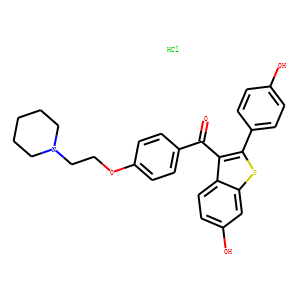| Overview of Clinical Research | <span style="color:#000000;"><span style="font-family:arial,helvetica,sans-serif;"><span style="font-size:12px;">Raloxifene is a s<span style="font-variant-ligatures: normal; orphans: 2; widows: 2;">elective estrogen receptor modulator. It is marketed to treat </span><span style="orphans: 2; widows: 2;">Breast cancer, Fracture and Postmenopausal osteoporosis.</span></span></span></span>
|
| Reference | 1. Cardiovasc Drug Rev. 2001 Spring;19(1):57-74.Cardiovascular effects of raloxifene hydrochloride.Saitta A(1), Morabito N, Frisina N, Cucinotte D, Corrado F, D/'Anna R, Altavilla D, Squadrito G, Minutoli L, Arcoraci V, Cancellieri F, Squadrito F.<br />
<br />
Raloxifene hydrochloride binds to the estrogen receptor and shows tissue-selective effects; thus, it belongs to a class of drugs recently described as selective estrogen receptor modulators (SERMs). Tissue selectivity of raloxifene may be achieved through several mechanisms: the ligand structure, interaction of the ligand with different receptor subtypes in various tissues, and intracellular events after ligand binding. Raloxifene has estrogen-agonist effects on bone and lipids and estrogen antagonist effects on the breast and uterus. In addition to its well established effects on osteoporosis, recent preclinical and clinical findings suggest that raloxifene also possesses beneficial effects on the cardiovascular system. These findings indicated that raloxifene may have cardioprotective properties without an increased risk of cancer or other side effects. Raloxifene has been shown to reduce total and low-density lipoprotein cholesterol concentrations in plasma, an effect similar to that produced by estrogens. Unlike estrogens, however, raloxifene does not increase high-density lipoprotein cholesterol and triglyceride levels in plasma. Endothelium is thought to play an important role in the genesis of atherosclerosis. Several lines of evidence suggest that an intervention with endothelial function might influence the progression of coronary disease and the incidence of cardiovascular events. Raloxifene increases the nitric oxide/endothelin-1 ratio, and improves endothelium-dependent vasomotion in post-menopausal women to the same extent as estrogens. Furthermore, in two randomized trials on post-menopausal women raloxifene reduced homocysteine levels, another independent risk factor for the development of cardiovascular disease. Although estrogens remain the drugs of choice in the hormonal therapy of most postmenopausal women, raloxifene may represent and alternative in women who are at risk of coronary artery disease.<br />
2. Ann Intern Med. 1999 Mar 2;130(5):431-9.Clinical effects of raloxifene hydrochloride in women.Khovidhunkit W(1), Shoback DM.<br />
<br />
PURPOSE: To review clinical data on raloxifene hydrochloride, a selective estrogen receptor modulator that was recently approved for the prevention of osteoporosis in postmenopausal women.<br />
DATA SOURCES: English-language articles published from 1980 to May 1998 were identified through MEDLINE searches. Bibliographies, book chapters, and meeting abstracts were reviewed for additional relevant publications. STUDY SELECTION: Publications that contained information on the background of development, structure, mechanism of action, tissue-selective effects, and adverse effects of raloxifene hydrochloride were included. DATA EXTRACTION: Data in selected articles were reviewed, and relevant clinical information was extracted.<br />
DATA SYNTHESIS: Raloxifene hydrochloride was developed in an effort to find a treatment for breast cancer and osteoporosis. It binds to the estrogen receptor and shows tissue-selective effects; thus, it belongs to a class of drugs recently described as selective estrogen receptor modulators. Tissue selectivity of raloxifene may be achieved through several mechanisms: the ligand structure, interaction of the ligand with different estrogen receptor subtypes in various tissues, and intracellular events after ligand binding. Raloxifene has estrogen-agonistic effects on bone and lipids and estrogen-antagonistic effects on the breast and uterus. An increase in bone mineral density at the spine, total hip, and total body has been reported with raloxifene but seems to be less than that seen with estrogen or alendronate therapy. Raloxifene has been shown to produce a reduction in total and low-density lipoprotein cholesterol concentrations similar to that produced by estrogen therapy, but high-density lipoprotein cholesterol and triglyceride concentrations do not increase during raloxifene therapy. In the uterus, raloxifene does not stimulate the endometrium. Long-term data on the effects of raloxifene in reduction of risk for fracture; prevention of cardiovascular events; cognitive function; and the incidence of breast, ovarian, and uterine cancer are not available. The most common adverse effect of raloxifene is hot flashes.<br />
CONCLUSIONS: Raloxifene has been shown to have beneficial effects in selected organs in postmenopausal women. Although estrogen remains the drug of choice for hormonal therapy in most postmenopausal women, raloxifene may be an alternative in certain groups of women at risk for osteoporosis.<br />
|

